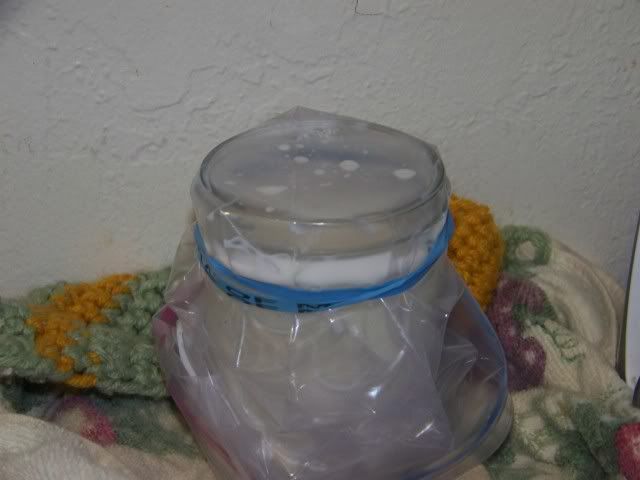Yogurt

This is my first attempt at following this homemade yogurt recipe. It was a very spontaneous decision to just go ahead and try it, since I have enough milk and some store-bought yogurt on hand to use as a starter. It's a very tiny batch: just enough to fit in the mason jar that I've had sitting around my kitchen for probably half a year now, ever since a friend gave me crazy delicious peach butter.
This first batch didn't go so well. I got it going around one or two yesterday afternoon, and this morning it was still milky. It did have a slight yogurt-y taste to it, but it was a lot more milk than yogurt. So I dumped it and started over again. I thought maybe I didn't add enough yogurt the first time. (I didn't feel like actually measuring out how much milk I had and making the proper conversions from the recipe so I just put a heaping spoonful in and called it good.)
When I made the second batch, I was trying to start clearing the dishes out while the milk heated. As a result, it heated up way more than the recommended 180 degrees: I think it was actually starting to boil before I took it off. I had no idea if that was going to affect the yogurt-making process or not. I thought about throwing it out and starting over with some new milk. But eventually I decided to go ahead and try it, to see what happens, but also to start another batch on the side. I grabbed a jam jar out of the recycling and washed it off (while finishing washing the dishes so that they wouldn't distract me again). I made both the second and third batch with close to half a 6-oz yogurt container each. I also (belatedly) put another towel around and over the two, in case the smaller towel was insufficient insulation for the first batch. Which, now that I think about it, is pretty likely.
It's getting to be evening now, and the two batches are still pretty milky (after... 7ish hours). I think I'll have to see how they are in the morning. But I'm guessing that a big problem is that I'm not insulating them well enough to keep them warm. Any more attempts will have to wait, though, until Ken has time to go grocery shopping and get us more milk. We're too low on it to use it up on experiments.



sorry you haven't had much luck so far! Harold McGee, who I got the recipe from (http://www.nytimes.com/2009/04/15/dining/15curi.html) says you can also put the containers in an oven with the light bulb on. and i know from trying to keep soup warm that box full of towels or crumpled newspaper makes a great insulator, too. especially with smaller containers, the temperature will drop pretty fast.
ReplyDeleteOooh, I could totally try the oven idea. Thanks!
ReplyDeleteanother tip from the nytimes today: "add 1 tablespoon dry skim milk (powdered milk) for each quart of milk. Use whole milk for the best results, and keep the bowl warm overnight, at least 90 degrees. I use my oven with the pilot light on." (http://dinersjournal.blogs.nytimes.com/2011/03/18/answers-on-canning-syrup-yogurt-and-tomatoes/?partner=rss&emc=rss)
ReplyDeleteSo Real Food claims that dry powdered milk is a source (probably the major source) of oxidized cholesterol, and that oxidized cholesterol - rather than the unoxidized cholesterol found naturally occurring in animals - is the source of heart disease. I haven't researched those claims much yet, but I have noticed that dry milk powder is quite a common listed ingredient. Since it doesn't have a tradition of many generations of healthy people being raised off of it (yet), it seems untested to me, and I am highly inclined to avoid it whenever it is convenient to do so.
ReplyDeleteI did make another batch of yogurt yesterday. I preheated the oven to "warm" (we have electric, so there's no pilot light), put the yogurt in, and then turned the oven off. I think that worked well to keep it warm, until about two hours later, when I began to get worried that I would forget about it and my husband would come home and preheat the oven without looking in it first, and burn the yogurt. So I took it out and wrapped it in towels. It was still pretty milky this morning, but not as badly as before. So I think if I can plan ahead to make the yogurt when I can leave it in the oven all day (or all night), I will have better luck with firming it up.
Planck also makes the claim that industrial yogurt (as opposed to "traditional, spontaneously fermented" yogurt) has bacteria that are specifically designed to only survive in milk, and therefore cannot provide the aid to digestion that traditional yogurt does. Yet another claim on my list of ones to research. :)